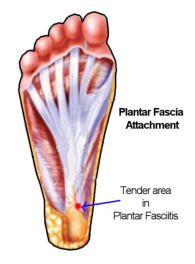

Information for the General Public
Painful Heel (Plantar Fasciitis)
About 10% of the population have suffered from heel pain at some time during their
life.
Women
suffer
more
often
than
men
and
it
usually
affects
after
the
age
of
50.
Many with diabetes may also present with a painful heel.
Symptoms:
Pain
is
often
severe
1
st
thing
in
the
morning
when
you
get
out
of
bed
and
pressure
applied
on
the
heel.
It
eases
a
little
as
you
start
walking
but
will
increase
again
if
you
are
on
your
feet
for
prolonged
periods
of
time.
Pain
is
usually
confined to the inner aspect of the heel.
Cause
for
the
Pain:
The
condition
is
called
Plantar
Fasciitis,
meaning
inflammation
of
the
Plantar
Fascia
(at
its
attachment
to
the
heel
bone).
Some
believe
that
the
inflammation
is
due
to
small
tears
of
the
fascia
near
its
attachment
to
the
bone
due
to
repeated
trauma.
There
may
be
some
thickening
of
the
fascia
at
this
site.
The
exact
cause
for
the
inflammation
is
still
difficult
to
understand.
If
it
occurs
in
diabetics,
its
the
obesity
that
contributes
to
the
pain.
Constant
running
or
walking on hard ground can also produce the pain.
Plantar
Fascia:
The
Plantar
Fascia
is
like
a
bowstring
attached
to
the
heel
bone
(Calcaneus)
at
one
end
and
to
the
bones
of
mid
foot
(metatarsals)
at
the
other
end.
This
helps
to
maintain
the
arch
of
the
foot
and
also
acts
like a shock absorber easing the strain when you walk or run.
Diagnosis:
of
Plantar
Fasciitis
is
made
by
examining
the
foot.
There
will
be
localised
tenderness
at
the
inner
side
of
the
heel
about
3
cms
from
the
edge.
There
should
be
no
numbness
in
the
foot.
Investigations
:
Tests
are
rarely
necessary.
However
if
there
is
any
doubt
about
the
diagnosis
an
x-ray
and
an
ultrasound
can
be
done.
This
is
to
rule
out
an
infection
or
other
pathology
of
the
bone.
Ultrasound
may
show
thickened
fascia
where
there is pain.
X-ray
may
sometimes
show
a
bony
spur
from
the
heel
bone.
This
is
unlikely
to
contribute
to
the
pain.
Many
among the population have a bony spur with no heel pain.
Treatment
:
1
.
Rest
2
.
Supportive Foot Wear
3
.
Medication
4
.
Physical Therapy
5
.
Steroid Injection
6
.
Surgery
Quite
often
pain
eases
after
a
period
of
time.
However
in
some
it
does
not
ease
and
those are the people who will seek treatment.
Rest:
The
general
advice
should
be
to
rest
the
foot
as
much
as
possible
and
avoid
running
or
standing
on
hard
surface.
Footwear:
Must
wear
footwear
with
a
soft
insole
and
a
good
arch
support.
It
is
also
worth
trying
an
insole
with
a
small
hole
cut
at
the
exact
area
where
the
tender
point
of
the
sole
comes
in
contact
with
the
insole.
This
would
relieve
the
constant
pressure
at
the
painful
area.
Generally,
do
not
walk
barefoot
on
any
surface
particularly
when it is hard.
Medication:
If
the
pain
is
severe
anti-inflammatory
medication
like
Ibuprofen
would
help.
Ibuprofen
gel
applied
locally two or three time a day may also help.
Physical
Therapy:
A)
Ice
cubes
in
a
plastic
bag
can
be
applied
over
the
tender
area
for
10
to
15
minutes
2
or
3


